Cusco Tetrarchy It was customary in Tahuantinsuyu that when the Zapa Inca was absent from Cusco, he always left his replacement. That assignment could fall to an auqui or to a meeting of orejones or nobles from Cusco. Those temporary rulers maintained almost daily communication with the Zapa Inca, wherever he was, thanks to the service of the quipucamayocs and the chasquis. Thus, for example, during the absences of Huaina Cápac, a tetrarchy of orejones or nobles governed Cusco. It was made up of Topa Cusi Huallpa (Huáscar Inca), Hilaquita, Auqui Topa Inca and Tito Atauchi. In Zapa Inca's entourage, there were always his other children:Ninancuyuchi and Atahualpa. Huáscar Inca was the son of Huaina Cápac and the coya Raura Ocllo. He was born in Cusco and belonged, by maternal descent, to the Tupac Inca Yupanqui lineage. He was more administrator than warrior. Atahualpa Inca was also the son of Huaina Cápac, but he had him with the ñusta Tupa Palla. There are chroniclers who maintain that his mother was called Tocto Coca. “She was called Toctollo”, says Santa Cruz Pachacútec. If so, his lineage descended from Pachacútec Inca Yupanqui.
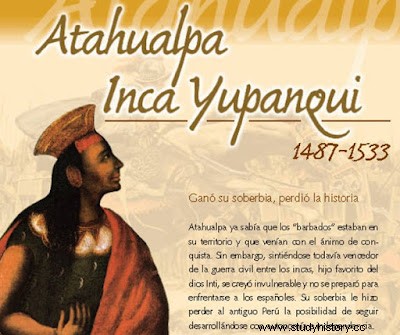
Who was the mother of the intrepid? But there are doubts about who was the mother of Atahualpa Inca. Let's see:1. There are those who affirm that she was born in Quito (for example:Inca Garcilaso de la Vega, Antonio Vázquez de Espinoza, Pedro Pizarro, Agustín Zárate, Pedro Gutiérrez de Santa Clara and Francisco López de Gómara). 2. Felipe Guamán Poma de Ayala affirms that he was born in Chachapoyas. 3. Marcos de Niza (according to Juan de Velasco, in his History of Quito) says that Huaina Cápac had married the last descendant of the Scyris ethnic group (from the kingdom of Quito). From that union, Atahualpa was born. The truth is that Atahualpa Inca stood out for his warrior spirit, earning the trust of his father and becoming his favorite.
Succession, illness and death However, Huaina Cápac had established the following order of succession:1. First option, his son Ninancuyuchi. 2. Second option, Huáscar Inca. Atahualpa Inca was not in his initial plans. That version is supported by the chroniclers Pedro Sarmiento de Gamboa, Juan Santa Cruz Pachacuti Yamqui, Bernabé Cobo, Martín de Murúa and Miguel Cabello Balboa. To ensure that he was chosen correctly, Huaina Cápac consulted with the augurs. A villaoma set out to make the sacrifices of the callpa (“the force or power of the soul or of the body; augur”). In that, Huaina Cápac fell ill with smallpox, in Quito. Given the seriousness of the situation, a special embassy, commanded by Cusi Topa Yupanqui, was sent to Tumipampa to notify Ninancuyuchi of his father's decision to replace him on the imperial throne. The villaoma returned to Quito discouraged by the “negative responses” from the augurs. Those sent to Tumipampa also returned to Quito. They arrived with the fatal news that Ninancuyuchi had passed away. Those bad reports could no longer be heard by the Zapa Inca, because Huaina Cápac had ceased to exist.
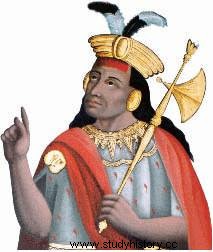 Huaina Cápac, the last of the great
Huaina Cápac, the last of the greatIncas. He died without determining who would be his heir The political contest The Tahuantinsuyu had been left headless; no official, real ruler. Faced with such a situation of uncertainty, the orejones of the imperial court who were in Quito concocted a stratagem. They decided to take the mummy of Huaina Cápac to Cusco, "as if he were alive, so as not to cause further confusion", but Atahualpa Inca and a group of nobles remained, suspiciously, in Quito. Instead, Raura Ocllo, the Coya, mother of Huáscar Inca, hurriedly left Quito for Cusco to give this news to her son. Another of her intentions was to convince the noble orejones to name Huáscar Inca as the new Zapa Inca. After her, recently the entourage, with the mummy of Huaina Cápac, first arrived in Limatambo; then to Cuzco. When the entourage arrived at the "Navel of the World", Huáscar Inca became angry, because he verified that Atahualpa Inca was not in it, confirming the version of his mother. He blamed the orejones "for not having taken it." In truth, Atahualpa Inca had disregarded the order given by his older brother, the auqui, to move to the imperial capital. Huáscar Inca lost all the confidence he had in Atahualpa Inca and came to believe that all those who carried the mummy of Huaina Cápac were accomplices of such an offense to his imperial investiture. For this reason, he ordered that they kill all the orejones of the delegation that came from Quito; which was done on the spot. That punishment, for some chroniclers, was carried out in Cusco; for others, in Limatambo. The orejones whom Huáscar Inca had executed belonged to the lineage of Pachacútec Inca Yupanqui. Chief among them was Cusi Topa Yupanqui. Therefore, this measure annoyed the panacas of Hanan Cusco.
The struggle of the panacas Atahualpa Inca went to Tumipampa, where he had several imperial public buildings built, presumably "in homage to Huáscar Inca". But the court intrigues in the "Navel of the World" increased. The huascaristas saw in all the acts of Atahualpa Inca the imminence of a betrayal and the atahualpistas thought they perceived in each gesture of Huáscar Inca the wishes of a hegemony in the benefits of the Empire, excluding him. Of course, those insinuations increased mistrust and increased mutual resentment between the two brothers.
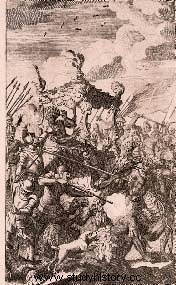 The Spaniards fire left and right
The Spaniards fire left and rightwhile the orejones try to hold the
Inca walk In that, for "bad evil", Ullco Colla, the curaca of Tumipampa, sent messengers to Huáscar Inca letting him know that Atahualpa Inca was trying to revolt. Huáscar Inca was furious again. This time, he blamed his mother and sister for allowing Atahualpa Inca to stay in the north. More than ever, he considered that Atahualpa Inca was a great danger to his throne. Unfortunately for Huáscar Inca, Atahualpa Inca was the favorite of the military, whose most important commanders had stayed with him in Quito and Tumipampa. Special messengers from Atahualpa Inca brought rich presents to Cusco for Huáscar Inca, to appease him and buy time. But the warned Huáscar Inca did not fall into the trap and the gifts were underestimated and said messengers were executed. They say that their skins were dried to turn them into hides, with which war drums were made. Huáscar Inca, out of mockery and provocation, sent Atahualpa Inca women's clothing and jewelry.
War, legend and mythology With all these attitudes, worthy of his time, the animosity between the brothers increased. Atahualpa Inca's generals took advantage of her and convinced him to make his rebellion public. From then on, civil war broke out. Two armies entered a campaign to fight for hegemony in Tahuantinsuyu. When Atahualpa Inca was still in Tumipampa, making preparations for the contest, he was taken prisoner. “He was captured by the Cañaris, loyal to Huáscar Inca”, say some chroniclers. “He was defeated by troops sent from Cusco, by Huáscar Inca”, say other chroniclers. What is certain is that he was locked up in a royal dairy, from where he was released during the night by his supporters. It is said that a mamacuna provided him with a copper bar with which he made a hole in the wall and managed to slip away without being noticed by his guards, "who were celebrating the triumph." Atahualpa Inca cunningly took advantage of this episode, because he made believe that the Inti had transformed him into an amaru (serpent) so that he could escape through a crack in the royal tambo. That legend spread throughout the Empire and turned Atahualpa Inca into a mythical being; the "chosen by the gods." The troops of Atahualpa Inca were reorganized in Quito. With his army well supplied, he returned to Tumipampa, taking said plaza. There, Atahualpa Inca took revenge on the Cañaris, because he destroyed the city founded by Túpac Yupanqui and converted by Huaina Cápac into his favorite llacta. Then he headed for the north coast, destroying all the towns as far as Tumbes. To take the curacazgo of La Puná, which was a supporter of Huáscar Inca and which was on the island of the same name, in the Gulf of Guayaquil, Atahualpa Inca gathered a respectable fleet of rafts, in order to invade it from the mainland. Warned of the Inca's intentions, the curaca of La Puná did the same, but on his island. Atahualpa Inca embarked his troop towards La Puná and the curaca of that island went out to meet him. At sea, the two war flotillas met and a fierce battle ensued. Atahualpa Inca was wounded in the leg and his troops bore the brunt and had to retreat to the mainland. From there, they moved to Quito. The victorious curaca of La Puná invaded Tumbes, devastated it and punished the garrison left behind by Atahualpa Inca, taking hundreds of prisoners. When Francisco Pizarro arrived at that site, he found 600 Atahualpista captives.
Huáscar Inca did not show leadership Meanwhile, Huáscar Inca, who had been chosen by the Cusco nobility as Zapa Inca, showed himself in Cusco as a "pusillanimous, violent, cruel and foolish" ruler. He failed to win the sympathy of the Inca ruling class or the respect of the generals of Huaina Cápac's army who were in the capital city. Furthermore, he became unpopular because: a). He did not attend the entertainment and meals that the panacas used to make in the main square of Cusco during their festivities. b). He separated from his personal guard the members of the custodian ayllus, distrusting them. In his replacement, a special group of Cañaris and Chachapuyas became his royal guard. c). He threatened to dispossess the panaca of their haciendas and other assets. But, what filled the indignation of the Cusco nobility was the decision of Huáscar Inca to bury the mummies that each panaca kept. They heard him say:"In Cusco there are more mummies than living." This fact was serious, because:“According to Cusco customs, the mummies of the deceased Incas were preserved as if they were alive, surrounded by their wives and servants. His were the best fields on the outskirts of Cusco, that is how the dead enjoyed greater wealth and privileges than the living. Around the bodies of the past sovereigns, a large entourage gathered that was sustained at the expense of the panacas, and occupied the capital in reciprocal parties, drunkenness and binge eating” (María Rostworowski). All these intentions of Huáscar Inca aroused the resentment of the members of the panacas, their many servants and cronies. Huáscar Inca, noticing that rejection, wanted to go from Hanan Cusco to Hurin Cusco. On the other hand, Atahualpa Inca, who had spent ten years away from the intrigues of the Cusco court, was gaining followers. In addition, he was backed by a good part of the imperial army and the most experienced and skilled generals.
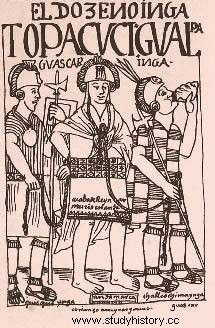 In the civil war, Huáscar Inca was
In the civil war, Huáscar Inca wasdefeated and imprisoned (drawing by Guamán Poma of Ayala) The northern campaign Huáscar Inca sent, under orders from General Atoc, a large army to Tumipampa. On this occasion, it was not just any symbol that said army was brandishing. A beautiful gold statue of Inti led the march. Atahualpa Inca, from Quito, commanded his troops under the orders of generals Challcochima, Quizquiz, Rumiñahui and Ucamari. The first meeting between the two armies took place in Chillopampa, with Atoc's troops triumphing. Miguel Cabello Balboa, the chronicler, says that this first meeting took place in Mullihambato. According to the same chronicler, the troops of Atahualpa Inca were victorious in a second battle. According to Pedro Cieza de León, there was only one battle between the armies of both Incas. But it is evident that in the northern campaign the final victory corresponded to the Atahualpa troops. Ullco Colla, curaca of Tumipampa, died in this campaign. Generals Atoc and Hango fell prisoner and were cruelly victimized. According to one version, they were blinded and abandoned in a lonely spot, where they died of hunger and thirst. According to others, they died in the presence of their enemies. From their skins, war drums would have been made. From Atoc's skull “Challcochima had a container made with gold decorations to drink chicha”, says a chronicler.
Central Sierra Campaign The Huascarist army -under the command of the orejones Huanca Auqui, Ahuapanti, Urco Huaranca and Inca Roca- left Cusco heading north. The Atahualpista army, commanded by Quizquiz and Challcochima, went to meet him. Both armies clashed in Caxabamba, leaving the Huascaristas defeated. Huanca Auqui managed to flee and reorganized his troops in Cajamarca. But, from then on, all the battles of that campaign will be decided in favor of the Atahualpa troops; to such an extent that the huascaristas only protected their retreat towards Cusco. The most important of these battles were:Cocha Huailla (Huancabamba-Huambo), Pumpu (Bombon plateau), Jauja (Mantaro valley) and Vilcas (Ayacucho).
Defense of the imperial capital Atahualpa Inca had stayed in Cajamarca. When his victorious troops were already in Curahuasi (passing Andahuaylillas; southeast of Cusco; province of Quispicanchis), Huáscar Inca multiplied his prayers to the huacas. Since the answers were always negative, he fell into almost total discouragement. But, faced with the imminent invasion of the “Navel of the World”, he was forced to face the situation, He Reorganized his army. He divided it into three fronts: A). The first, commanded by himself, guarded by noble warriors from Hurin Cusco, Cañaris and Chachapoyas. B). The second, by Uampa Yupanqui, who led his army towards Cotabambas, where Atahualpa Inca's troops had retreated. C). The third, under the leadership of Huanca Auqui, who had the mission of monitoring and attacking the enemy by surprise.
 Request to Atahualpa Inca made by the
Request to Atahualpa Inca made by theDominican Vicente Valverde, with the presence
by Hernando de Aldana and Felipillo. Guanacopampa Both armies met in Guanacopampa (Tambobamba district, Cotabambas province, Apurímac Region). The first Huascarist echelon that entered the battle was the one commanded by Uampa Yupanqui. Aware that General Tomay Rima had died among the atahualpistas and, for that reason, anticipating a final victory, Huáscar Inca ordered the participation of the other echelons. His brothers Tito Atauchi and Topa Atao stood out in the fight. The battle was fierce. It lasted all day and neither army surrendered. At nightfall, Quizquiz and Challcochima withdrew to a nearby hill. Huáscar Inca, noticing the dry grass that surrounded them, made them set fire. Scorched by the fire, many Atahualpista soldiers died. Then, his leaders ordered the withdrawal and crossed the Cotabambas River, but Huáscar Inca made the mistake of not pursuing them. The next day, Topa Atao went to meet Challcochima in a hollow, but Challcochima defeated him and took him prisoner. Later, he ordered Quizquiz to take the sovereign prisoner from the rear. Huáscar Inca fell into the ambush and was taken prisoner. Immediately, Challcochima took his litter, got on it carried by his supporters and, posing as the Zapa Inca, went to Guanacopampa, where a large part of the army of Huáscar Inca was armed. There, at first they believed that their Inca was returning victorious. But the skillful general Challcochima released a prisoner to warn that the Zapa Inca had fallen into his power. Then, the rival troops, totally disconcerted, began to flee through the Cotabambas River. When they crossed to the other shore, Challcochima's troops fell on them, defeated them and took General Tito Atauchi prisoner.
The imperial city is taken The imprisoned Huáscar Inca, with special custody, remained in Quiuipay. The victorious Atahualpista troops advanced towards Cusco. They arrived in Yavira, very close to the capital city, to rest and receive orders from Atahualpa Inca, the usurper Zapa Inca. Informed of these events, the most important characters of the Cusco nobility arrived in Yavira to pay homage to Atahualpa Inca, who was represented by a statue; the double or huauque of him, called Ticsi Cápac. Challcochima ordered an exemplary punishment against the Huascarist general Huanca Auqui and the villaomas Apo Challco Yupanqui and Rupaca, blamed for having delivered the mascapaycha to Huáscar Inca. Later, the atahualpistas took Cusco without any other mishap. Elated by the final victory, Atahualpa Inca sent Cusi Yupanqui to Cusco with special powers, mainly to punish the supporters of Huáscar Inca. A precise provision was revealed shortly after his arrival:annihilate the panaca of Túpac Inca Yupanqui and the lineage of Huáscar Inca. Indeed, the women, children and relatives of Huáscar Inca were executed. They destroyed the mallqui of Túpac Inca Yupanqui, burning it in an unpopulated area. That act was considered at that time as the vilest of punishments. Then, they persecuted and killed all the members of their panaca, including their mamaconas, yanas and other servants.
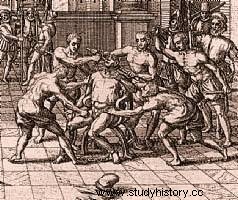 Colonial engraving on the death of Atahualpa “Strange and fierce bearded men” When Atahualpa Inca was in Huamachuco, preparing to travel to Cusco, some messengers arrived sent by the curacas of Paita and Tumbes. They informed the Zapa Inca that some “strange characters who inhabited floating houses and rode huge animals” had arrived. Atahualpa Inca ordered that Huáscar Inca be taken to Cajamarca, where he himself also went to be more aware of the displacement of those barbados in the lands of "his empire". Francisco Pizarro and his troops found out about this news while in Tangarará, where they founded the city of San Miguel. Pizarro calculated his actions and did not rush. He knew that the course of history was in his favor. The end of Tahuantinsuyu was drawing near. On November 15, 1532, Pizarro arrived at the llacta of Cajamarca, while Atahualpa Inca was waiting for him at the Baños del Inca, 5 km from the city. Without getting off his horse, Pizarro ordered Hernando de Soto, first, and Hernando Pizarro, later, to go and invite him to the Inca. Atahualpa Inca was serene, sure, even arrogant, before the embassy and offered to visit them the next day. He did not take any warrior foresight. Instead, the Spanish prepared the ambush. The next day, when Inti was already hidden, Pizarro's entourage arrived in Cajamarca. Atahualpa Inca, the Lord of Chincha and the Lord of Cajamarca appeared on shining litters and entered the Plaza de Cajamarca. They were met by the Dominican priest Vicente Valverde, who made the request or submission to the Spanish Crown, which Atahualpa Inca angrily rejected. Valverde said:“Santiago! Santiago!”, the war cry that Pizarro and his hosts were waiting for. The horsemen came out, the bulldogs, the foot riflemen, and the four culverins began to fire their bullets. Everything went haywire and the Inca's companions panicked and began to escape, thousands dying in that attempt before the onslaught of the Pizarrista troops. Francisco Pizarro took advantage of the occasion to take Atahualpa Inca prisoner, with which the victory was assured by the conquerors. Days later, Atahualpa Inca, understanding the ambition of the Spanish, offered them a fabulous amount of gold and silver for their freedom. Pizarro hypocritically accepted the offer. The treasure of the Incas began to arrive from all over Tahuantinsuyu, one of the largest that any conqueror has obtained in the history of humanity. The Spaniards melted down all the gold art objects and divided up the ingots, sending the "fifth real" to Spain. Immediately, they "tried" Atahualpa Inca and sentenced him to be burned alive. The Inca asked for mercy, was baptized and was killed with the penalty of the club. It was July 26, 1533, the date on which the independent development of Andean culture ended.
Colonial engraving on the death of Atahualpa “Strange and fierce bearded men” When Atahualpa Inca was in Huamachuco, preparing to travel to Cusco, some messengers arrived sent by the curacas of Paita and Tumbes. They informed the Zapa Inca that some “strange characters who inhabited floating houses and rode huge animals” had arrived. Atahualpa Inca ordered that Huáscar Inca be taken to Cajamarca, where he himself also went to be more aware of the displacement of those barbados in the lands of "his empire". Francisco Pizarro and his troops found out about this news while in Tangarará, where they founded the city of San Miguel. Pizarro calculated his actions and did not rush. He knew that the course of history was in his favor. The end of Tahuantinsuyu was drawing near. On November 15, 1532, Pizarro arrived at the llacta of Cajamarca, while Atahualpa Inca was waiting for him at the Baños del Inca, 5 km from the city. Without getting off his horse, Pizarro ordered Hernando de Soto, first, and Hernando Pizarro, later, to go and invite him to the Inca. Atahualpa Inca was serene, sure, even arrogant, before the embassy and offered to visit them the next day. He did not take any warrior foresight. Instead, the Spanish prepared the ambush. The next day, when Inti was already hidden, Pizarro's entourage arrived in Cajamarca. Atahualpa Inca, the Lord of Chincha and the Lord of Cajamarca appeared on shining litters and entered the Plaza de Cajamarca. They were met by the Dominican priest Vicente Valverde, who made the request or submission to the Spanish Crown, which Atahualpa Inca angrily rejected. Valverde said:“Santiago! Santiago!”, the war cry that Pizarro and his hosts were waiting for. The horsemen came out, the bulldogs, the foot riflemen, and the four culverins began to fire their bullets. Everything went haywire and the Inca's companions panicked and began to escape, thousands dying in that attempt before the onslaught of the Pizarrista troops. Francisco Pizarro took advantage of the occasion to take Atahualpa Inca prisoner, with which the victory was assured by the conquerors. Days later, Atahualpa Inca, understanding the ambition of the Spanish, offered them a fabulous amount of gold and silver for their freedom. Pizarro hypocritically accepted the offer. The treasure of the Incas began to arrive from all over Tahuantinsuyu, one of the largest that any conqueror has obtained in the history of humanity. The Spaniards melted down all the gold art objects and divided up the ingots, sending the "fifth real" to Spain. Immediately, they "tried" Atahualpa Inca and sentenced him to be burned alive. The Inca asked for mercy, was baptized and was killed with the penalty of the club. It was July 26, 1533, the date on which the independent development of Andean culture ended. Colonial painting on the death and funeral of the Inca Atahualpa SOURCE:JUlio Villanueva Sotomayor Biography "Atahualpa Inca Yupanqui"
Colonial painting on the death and funeral of the Inca Atahualpa SOURCE:JUlio Villanueva Sotomayor Biography "Atahualpa Inca Yupanqui" 